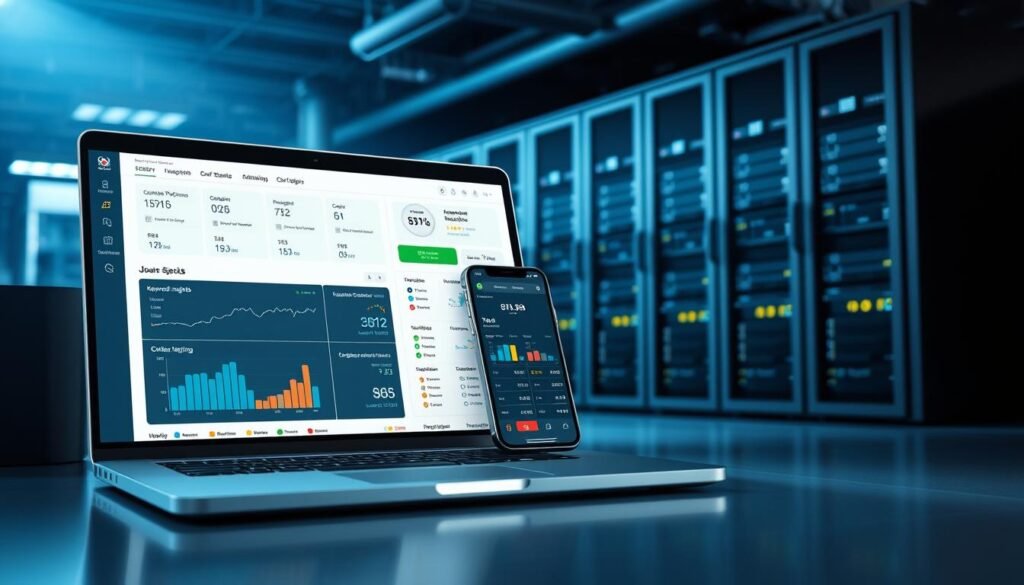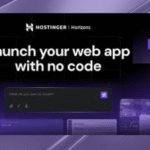Can one tool stack keep your brand visible when AI reshapes search and shrinks organic clicks?
You need a clear framework to compare tools fast scalable SEO Software. Search is changing. AI now appears in results alongside Google and YouTube. That squeezes clicks and raises the cost of mistakes.
Picking the right tools helps teams move faster and make smarter choices. Look for platforms that deliver reliable data, quick analysis, and easy integrations. That way, you protect visibility and conversions as the landscape shifts.
This guide translates technical features into plain language. We show how to weigh pricing by plan and month, map features to workflows, and judge options from Semrush, Ahrefs, Screaming Frog, and SEOGets. Expect practical advice for agencies and in-house teams managing multiple sites and client needs.
Key Takeaways
- Focus on speed to insight, data coverage, and integrations.
- Match features to your site’s complexity and brand needs.
- Compare pricing by plan and month against real workflows.
- Prioritize tools that cut manual work and improve results.
- Ensure access controls and client-ready outputs for agencies.
Why scalability matters now: AI-led search, squeezed clicks, and faster decisions
AI answers now occupy prime screen real estate, reshaping how brands get discovered. That shift reduces classic blue-link exposure. Your visibility depends on being cited, summarized, and shown positively by engines and large models.

Enterprise-grade tracking reveals who appears where. Platforms like Semrush Enterprise AIO track mentions across ChatGPT, Gemini, Perplexity, Claude, and Google AI Overviews. They report sentiment, citations, and share of voice.
Free tools also help. HubSpot’s AI Search Grader scores brand sentiment and share of voice across AI search engines. It then offers clear recommendations you can act on in a month.
From quick hacks to repeatable systems
With clicks squeezed, teams need fast insights. Unified dashboards, prioritized alerts, and clear next steps compress time from question to decision. Standardized research and reporting replace ad-hoc tricks.
- Visibility: Be cited, not just ranked.
- Data: Monitor mentions, sentiment, and share of voice.
- Execution: Turn alerts into tasks that improve content and performance.
| Need | What to measure | Representative tools | Outcome in 30 days |
|---|---|---|---|
| AI presence | Mentions, citations, sentiment | Semrush Enterprise AIO, HubSpot AI Search Grader | Clear list of pages to optimize for model answers |
| Decision speed | Alerts, unified dashboards, prioritized tasks | GA4 + GSC connectors, Looker Studio dashboards | Faster approvals and measurable traffic gains |
| Reporting | Share of voice, performance trends, month comparisons | Agency reporting tools, custom dashboards | Client-ready reports that explain AI-era results |
What “scalable” means for SEO software in 2025
Managing dozens of domains and teams demands tools that stay fast and predictable as you grow.
From one site to portfolios: multi-domain, multi-user realities
Real scale means governance and clarity. Agencies need role-based access, client portals, and audit logs so work stays secure and predictable.
White-label reports and branded dashboards keep your agency voice front and center. Platforms like SE Ranking, WebCEO, and AgencyAnalytics focus on multi-client workflows and permissions.
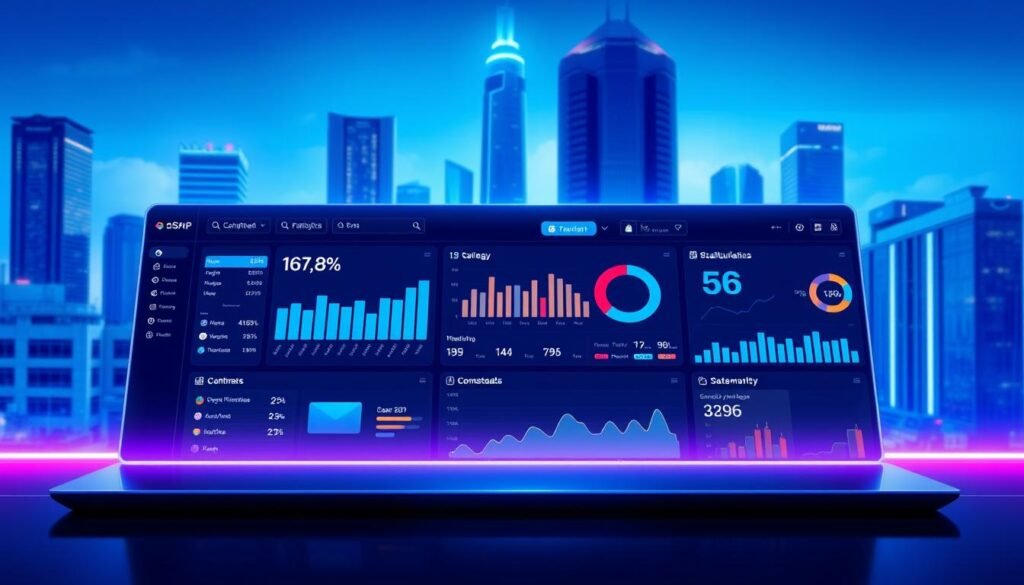
Workflows that grow with content volume, data, and stakeholders
As content and data increase, speed matters. Look for bulk operations, API enrichment, and project-level guardrails to avoid slowdowns.
Integration matters too. GA4, GSC, and Looker Studio centralize KPIs. Slack and CRM hooks align optimization with sales and support.
Collaboration features — tasks, comments, shared views — turn a tool into a team hub and cut context switching.
| Need | Key features | Representative platforms | Benefit |
|---|---|---|---|
| Multi-client management | Client portals, role-based access, audit logs | SE Ranking, AgencyAnalytics | Consistent delivery and secure access |
| Reporting at scale | White-label templates, automated exports, scheduled reports | WebCEO, AgencyAnalytics | Branded, repeatable client reports |
| Performance & ops | Bulk edits, API, project guardrails | SEOGets, SE Ranking | Fast, reliable analysis across sites |
| Integrations | GA4, GSC, Looker Studio, CRM, Slack | Most modern platforms | Unified data for better decisions |
Map your business use cases before you pick tools
Start by matching real daily tasks to the capabilities a tool delivers. This keeps choices practical and tied to results. Define the work your team does: briefs, competitor analysis, technical checks, and client reporting.
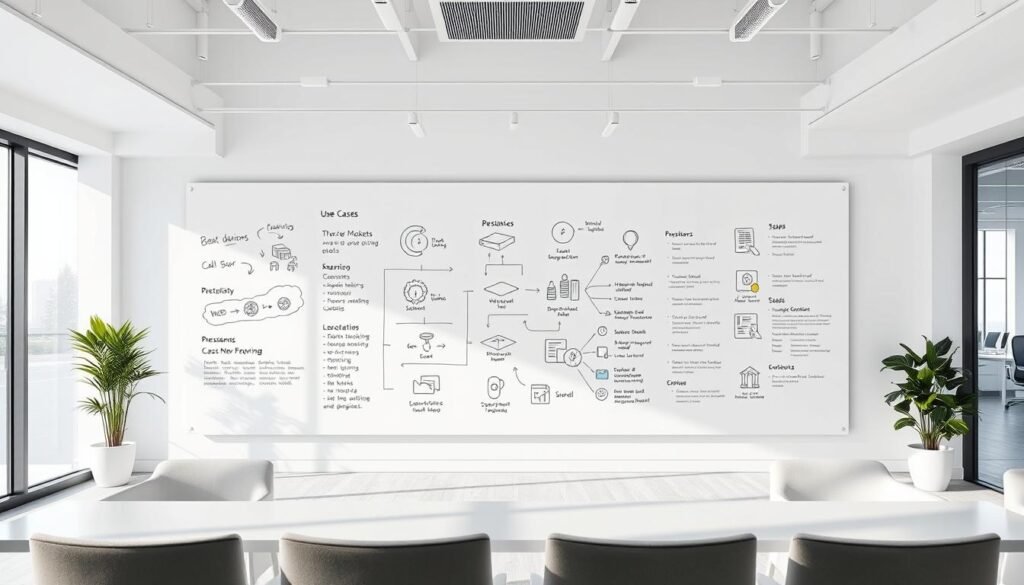
SMBs: fast wins with lean toolkits
Small teams need clear wins. Choose budget-friendly platforms like Mangools or Ubersuggest for keyword research and basic rank tracking.
Look for fast onboarding, guided workflows, and low monthly pricing.
Agencies: client access, branded reports, and workflows
Agencies require role-based access, white-label reports, and task flows. Platforms such as SE Ranking, WebCEO, and AgencyAnalytics deliver those features and cut manual reporting time.
Enterprises: AI search visibility and cross-channel data
Large teams prioritize AI-driven visibility and unified data. Semrush Enterprise AIO offers monitoring across ChatGPT, Gemini, Perplexity, and Google AI Overviews with sentiment and citation tracking.
- Map daily tasks to feature sets: content briefs, competitor analysis, technical audits.
- Align plan limits—projects, seats, credits—to growth to avoid mid-quarter stalls.
- Favor tools that send time-saving insights and alerts to shift teams to proactive optimization.
| Use case | Must-have features | Representative tools | Pricing note (per month) |
|---|---|---|---|
| SMB growth | Keyword research, simple rank tracking, guided briefs | Mangools, Ubersuggest | Low entry price; limited projects |
| Agency delivery | White-label reports, client access, task management | SE Ranking, WebCEO, AgencyAnalytics | Mid-tier plans with seats and branded dashboards |
| Enterprise governance | AI search visibility, cross-channel data, audit logs | Semrush Enterprise AIO | Custom plans; monthly pricing by data volume |
Core features to prioritize: research, tracking, analysis, and reporting
Choose features that turn raw data into clear, prioritized actions for your team. Focus on tools that pair deep research with practical workflows. That reduces guesswork and speeds decisions.
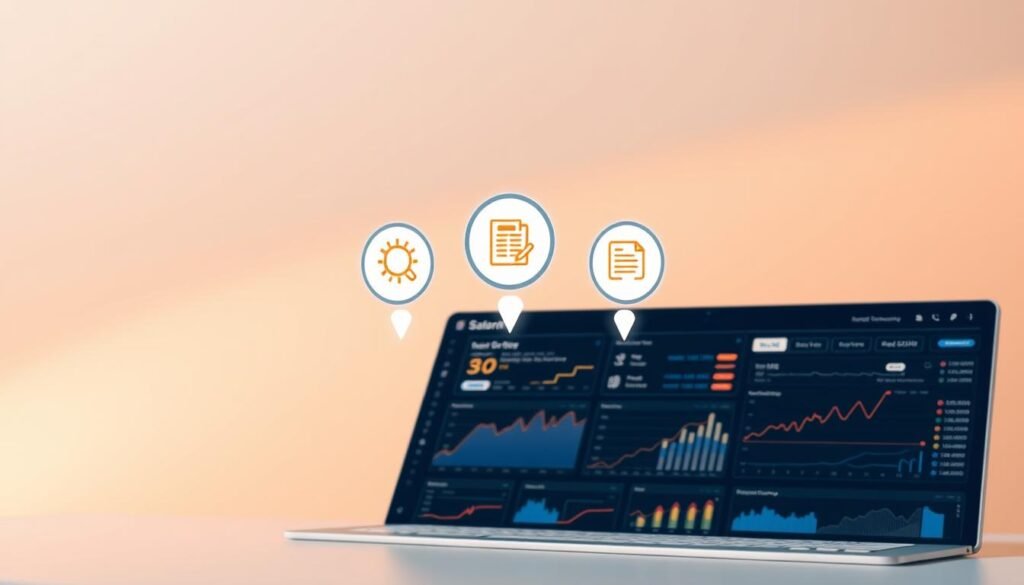
Keyword research and search intent modeling
Keyword research must go beyond volume. Look for topic maps, intent clusters, and AI suggestions that reveal user needs.
Semrush and Ahrefs offer Organic Research, AI suggestions, and topic insights to build briefs tied to intent.
Rank tracking at scale across search engines and locations
Daily rank tracking should include SERP features and local variations across major search engines. SE Ranking and Nightwatch deliver reliable daily updates.
Competitor analysis and share of voice
Competitor analysis must show where rivals win by topic and by channel. Share-of-voice metrics reveal opportunity gaps and quick wins.
Technical auditing and site performance insights
Screaming Frog integrates GA4 and GSC for audits that tie crawl issues to real user metrics. Sitebulb adds visualizations that help execs approve fixes faster.
Prioritize integrations with GA4 and GSC, automated reports you can white-label, and fresh data coverage from tools like Ahrefs and Semrush.
Integration and data flow: GA4, GSC, Looker Studio, CRM, and AI platforms
Connecting data streams turns scattered signals into clear, actionable steps.
Unify metrics so one dashboard guides every decision. WebCEO, SE Ranking, and AgencyAnalytics plug into GA4, GSC, and Looker Studio for client-ready reports. Semrush Enterprise AIO and the AI SEO Toolkit add signals from ChatGPT, Gemini, Perplexity, and Google AI Overviews.
Screaming Frog enriches crawls by pulling GA4 and GSC via API. That ties technical issues to real user behavior and performance.
Unifying dashboards for faster decisions and better reports
Build a single view that mixes GA4, GSC, rank data, and custom KPIs. Teams and users then work from one source of truth.
Connect CRM to attribute leads and revenue to organic research and optimization. Slack or email alerts keep the team informed when anomalies appear.
- API enrichment: automate exports to Looker Studio for stakeholder-friendly visuals.
- AI signals: add share of voice and sentiment to monitor brand visibility across generative search.
- Access controls: role-based permissions show clients only what they need.
| Need | Integration | Representative tools | Benefit |
|---|---|---|---|
| Client reporting | GA4 + GSC + Looker Studio | WebCEO, AgencyAnalytics | Clear, branded reports that execs understand |
| AI visibility | Generative engine signals | Semrush Enterprise AIO, AI SEO Toolkit | Monitor mentions, sentiment, and share of voice |
| Technical analysis | Crawl + behavioral data via API | Screaming Frog | Fixes prioritized by real user impact |
| Revenue attribution | CRM connectivity | AgencyAnalytics, SE Ranking connectors | Close the loop between work and business outcomes |
Pricing and plans: how “per month” models impact long-term ROI
Monthly bills hide the true cost of growth unless you check seats, credits, and export limits. Headline pricing is a start, but the fine print controls your real spend. Review user costs, API access, and project caps before you commit.
Seats, credits, and project limits to watch
Look beyond the sticker price. Semrush Pro starts at $139.95 per month and often adds user fees. Ahrefs tiers range from $129 to $1,499 per month. Smaller options include SEOGets at $49/month and Ubersuggest Agency at $40/month. Screaming Frog is priced yearly ($259), while Sitebulb cloud begins near $245/month.
- Scrutinize exports and API limits: they block large audits and automated reports.
- Match users to tiers: adding seats can change ROI more than extra features.
- Check white-label and client portals: agencies need these included, not as add-ons.
- Mix subscriptions: use monthly SaaS for core work and one-time licenses for heavy crawls.
“Confirm export limits, API access, and white-label options in writing to avoid surprises during growth.”
| Tool | Starter price | Notable limits | Best for |
|---|---|---|---|
| Semrush Pro | $139.95 per month | Additional user costs, project caps | All-in-one research and tracking |
| Ahrefs | $129–$1,499 per month | Plan-tiered limits on projects & exports | Backlink depth & content exploration |
| SEOGets / Ubersuggest | $49 / $40 per month | Lower limits, budget-friendly | Small teams and quick audits |
| Screaming Frog / Sitebulb | $259/yr / $245 per month | Desktop vs cloud licensing differences | Technical crawls and one-time migrations |
Tip: Use trials and annual discounts to validate workflows. That reduces surprises and aligns costs with the results you need.
Best SEO tools for competitor analysis and opportunity discovery
A focused competitor audit shows where your brand can leap ahead fast.
Start with Semrush. Use Domain Overview to benchmark traffic trends, ranking splits, and branded vs. non-branded reliance. Organic Research surfaces topic clusters that drive competitor growth.
Semrush Enterprise AIO tracks brand mentions, sentiment, citations, and share of voice across ChatGPT, Gemini, Perplexity, Claude, and Google AI Overviews. For SMBs, the AI SEO Toolkit (about $99 per month per domain) offers share-of-voice monitoring and sentiment signals.
Pair with Ahrefs for backlink and content depth
Ahrefs excels at backlink analysis and Content Explorer. Use it to find linkable assets and content gaps. Its AI suggestions and AI Content Helper (beta) speed keyword expansion and draft ideas.
- Use Semrush Domain Overview to benchmark competitors’ traffic and ranking mix.
- Monitor AI search visibility with Enterprise AIO or the AI SEO Toolkit.
- Explore topics in Organic Research to spot growth categories.
- Pair Ahrefs for backlink depth and Content Explorer to surface link targets.
- Compare per month pricing and data coverage to decide if both tools add material upside.
“Turn competitive insights into briefs and experiments—then measure whether share of voice and rankings move as planned.”
Technical SEO at scale: desktop crawlers and cloud options
Large site audits demand tools that combine precision crawls with behavior data for clear fixes. Choose a crawler that links errors to user metrics so your team can prioritize work that moves performance.
Screaming Frog: precise crawls and API enrichment
Screaming Frog costs $259 per year and runs full-site crawls or targeted URL lists. It integrates with GA4, GSC, and OpenAI to add behavior data and draft meta content at scale.
Use it when you need fine-grained extraction, custom rules, and API enrichment that tie crawl issues to low-CTR pages and conversion leaks.
Sitebulb: visualization-forward cloud audits
Sitebulb excels at clear visuals—graphs, heatmaps, and interactive reports that speed stakeholder buy-in. Cloud crawling starts around $245 per month for concurrent, large-site work.
For teams and agencies, cloud options handle multiple projects and deliver repeatable templates for faster audits and exports.
- Choose Screaming Frog for customizable crawls and OpenAI enrichment to draft meta text.
- Run targeted or full-site audits to validate product pages, blogs, or migration sections.
- Connect GA4 & GSC to spot low-CTR pages and fix titles, metas, and internal links first.
- Prefer Sitebulb when visual explanations and interactive reports matter to stakeholders.
- Standardize templates so each audit produces prioritized tasks with estimated impact.
Content and on-page optimization: outlines, NLPs, and topical authority
Strong on-page content turns ranking signals into measurable traffic and conversions. Use briefs and real-time scoring to keep drafts focused on intent and user needs.
Surfer for live content scoring and briefs
Surfer analyzes 500+ on-page signals and first-page data to generate outlines and live content scores. Plans start near $79 per month when billed annually. Scale and Enterprise tiers add credits and API access for high-volume pipelines.
Clearscope and alternatives for coverage
Clearscope improves relevance and coverage with AI-driven term suggestions and integration with editors and CMS. Use it alongside Surfer to validate depth and avoid thin, me-too pages.
- Use Surfer to build briefs and align drafts to NLP entities.
- Generate outlines fast, then refine for brand voice and unique value.
- Pair with Clearscope to confirm topic coverage and authority.
- Analyze underperforming pages to find missing subtopics and weak headings.
- Track content score improvements against CTR and conversions.
Close the loop: create a repeatable brief template (keywords, headings, internal links, FAQs) and connect it to your CMS QA checklist. Budget credits per month to match publishing cadence and avoid shortages mid-sprint.
Keyword clustering and search intent: building topic clusters that rank
A smart clustering approach converts long keyword lists into actionable content maps that drive category growth.
Turn messy keyword lists into structured topics. Clustering reduces cannibalization by grouping semantically similar queries that should live on the same page. That improves page-level authority and user relevance.
Keyword Insights for large-scale clustering
Keyword Insights can group up to 200,000 keywords using live SERP data. It surfaces clusters where SERPs overlap so you avoid competing pages.
Use it when freshness and scale matter. The tool helps prioritize which clusters need single pages and which need supporting subpages.
Semrush Keyword Strategy Builder for database-driven clusters
Semrush’s builder creates pillar and subpage clusters from up to five seed terms. It taps a 25.3B keyword database and returns volume, difficulty, and other metrics for prioritization.
- Map clusters to content types—guides, comparison pages, and FAQs—based on search intent.
- Build internal linking from pillar to cluster pages to distribute authority and guide visitors.
- Validate clusters with competitor analysis to find gaps you can own.
- Monitor results by topic cluster, not just individual pages, to measure category momentum.
- Iterate quarterly as intent and SERP features shift the ideal page structure.
“Organize by topic, measure by cluster, and evolve with the SERP.”
Rank tracking and visibility: across Google, YouTube, and AI results
Daily position checks reveal where content wins or needs urgent fixes across engines and video results. Trackers now report not only classic ranks but SERP features and AI mentions. That gives a fuller view of your visibility and impact.
Use daily data to act fast. SE Ranking, Nightwatch, and Semrush provide daily tracking with SERP features and share of voice. Ahrefs adds rank tracking with AI overview signals. Semrush Enterprise AIO measures brand mentions, sentiment, citations, and share of voice across ChatGPT, Gemini, Perplexity, Claude, and Google AI Overviews.
Daily position tracking, SERP features, and share of voice
- Track daily positions across Google and YouTube and record snippets, FAQs, and video placements to understand true visibility.
- Use share of voice to quantify category presence vs. competitors, not just isolated keyword ranks.
- Combine rank data with GSC impressions and clicks to spot early gains or losses and move fast on fixes.
Monitoring AI-generated answers and brand mentions
Monitor AI-generated answers for brand mentions, sentiment, and citation frequency. Alerts for feature loss or drops (featured snippets, video slots) help triage urgent fixes.
Present results as executive-ready reports. Segment by intent, device, and location. Tie rank changes to traffic and conversions. That makes research and reports meaningful for business decisions.
| Need | What to track | Representative tools | Outcome |
|---|---|---|---|
| Daily rank visibility | Positions, SERP features, YouTube ranks | SE Ranking, Nightwatch, Semrush | Faster detection of wins & losses |
| AI mentions | Citations, sentiment, model answers | Semrush Enterprise AIO, Ahrefs | Protects top-of-funnel discovery |
| Share of voice | Category presence vs. competitors | SE Ranking, Semrush | Quantified competitive position |
| Actionable reports | Segmented data by intent, device, location | All major tracking tools + GSC | Executive scorecards tied to conversions |
Agency-ready capabilities: white-label, client portals, and collaboration
Agencies need client-ready interfaces that make technical data easy to act on. Choose tools that package complex metrics into clear, branded views your clients actually read.
SE Ranking’s Agency Pack offers white-labeled domains, automated reporting, lead-gen widgets, and direct client access. WebCEO centralizes dashboards, task management, and broad integrations. AgencyAnalytics focuses on full white-labeling, client portals, and granular permissions.
- Client portals & role-based access: give each stakeholder only the data they need.
- Automated branded reports: reduce manual work and keep delivery consistent.
- Lead-gen widgets & marketplace visibility: help grow pipeline from within the tool.
- Central dashboards: support comments, tasks, and shared views so your team stays aligned.
- Validate integrations: GA4, GSC, and Looker Studio support unified reporting and faster insights.
- Watch pricing and plans: ensure users and access are covered without surprise fees.
“Build repeatable onboarding templates and baseline dashboards so every new client launches fast and clearly.”
Track client-facing results with a simple narrative: what changed, why it matters, and the next steps. That turns reports into decisions and keeps your agency delivery predictable and trusted.
Operational intelligence from your own data: GSC and trend detection
Your Google Search Console data can become a short-cycle decision engine for content and pages. SEOGets unifies multiple properties and turns raw GSC into clear signals you can act on in days.
SEOGets ($49/month with a free version) groups topics, content clusters, and URL-based content groups. It highlights rising keywords, decaying pages, and sections that pull most impressions and clicks.
Managers compare MoM and YoY periods to separate seasonality from true declines. That makes prioritization simple and fast.
How teams use SEOGets day-to-day
- Centralize GSC across sites to see cluster momentum and pages losing traction at a glance.
- Track content groups by URL structure to spot which sections drive performance and traffic.
- Flag decaying pages and prioritize updates, internal links, or fresh angles to recover rankings.
- Detect surging demand to create opportunistic content before competitors react.
- Export concise reports that state what changed and what you will do next.
| Need | Feature | Outcome |
|---|---|---|
| Multi-site trend view | Unified GSC across properties | Faster detection of rising keywords and decays |
| Section-level analysis | Content groups by URL | Clear view of which pages drive traffic and impressions |
| Actionable reporting | Exportable concise reports (MoM/YoY) | Shorter review cycles and faster fixes |
“Operational intelligence is about days, not weeks, from signal to change.”
Tie findings to rank and traffic results to validate whether updates move the needle. Fast tracking of GSC signals makes your workflow reactive and strategic at once.
Lightweight helpers that save time: extensions and assistants
Quick extensions and assistants free your team to focus on higher-value strategy. Use small helpers for routine checks and drafts so experts spend more time on impact.
Detailed for instant on-page checks
Detailed is a free Chrome extension that exposes titles, meta, headers, links, canonicals, schema, and hreflang for fast on-page checks. It shows the key features of a page without opening a heavy platform.
Use it to spot errors on a website, review competitor heading patterns, or confirm canonical tags before a publish. These micro-checks cut review time and reduce simple mistakes.
ChatGPT for brainstorming, briefs, and meta iteration
ChatGPT (free and paid) speeds brainstorming, meta variants, and short competitive summaries. Paste GA4 or GSC extracts to get concise, actionable analysis and suggested edits.
Create project spaces or Canvas boards to store prompts, drafts, and reference files. That keeps users aligned and helps the team move from idea to brief faster.
- Spot-check pages with Detailed to confirm titles, canonicals, and schema quickly.
- Summarize competitor content, then convert gaps into briefs for writers.
- Use assistants to generate meta options that match intent and length limits.
- Pair AI with your data: paste extracts for targeted recommendations.
“Use small helpers to speed routine work so your team can focus on quality and results.”
Note: Always review AI outputs for accuracy, tone, and brand fit before publishing. These helpers save time, but human validation keeps standards high.
Top picks: scalable seo software shortlists by scenario
A focused shortlist makes procurement simple and keeps month-to-month pricing predictable. Below are practical stacks you can deploy fast, mapped to common team sizes and goals.
SMB stack: budget-friendly research, tracking, and on-page
Fast wins with low monthly cost. Pair Ubersuggest (Agency plan ~$40/month) or Mangools for keyword research with Surfer for on-page briefs (~$79/month annual).
Use Detailed (free) for quick page checks and ChatGPT for ideation. Add a lightweight rank tracker and GSC or SEOGets for performance trend monitoring.
Agency stack: reporting, permissions, lead gen, and multi-client scale
Pick SE Ranking (from ~$52/month with Agency Pack) or WebCEO (~$83/month) for white-label portals and client access.
Layer AgencyAnalytics (from $179/month) for executive dashboards and automated reports. Standardize role-based access to protect client data and control users.
Enterprise stack: AI visibility, integrations, and governance
Combine Semrush Enterprise AIO for AI visibility with Ahrefs Advanced/Enterprise for deep backlink and content data.
Add Sitebulb Cloud (~$245/month) or Screaming Frog for large audits, and connect Looker Studio plus your CRM for executive reports and attribution.
- Map each stack to reporting cadence, plan tiers, and per-month pricing to protect ROI.
- Standardize access and user roles so teams and agencies scale without friction.
- Revisit shortlists quarterly to capture new features, data improvements, and changing competitive landscapes.
“Match tools to the work you actually do, not the shiny features you might never use.”
Conclusion
Close the loop between analysis and action to make every update measurable.
AI now shares SERP space with classic listings. Protect visibility by pairing research, tracking, analysis, and reporting across tools like Semrush, Ahrefs, Screaming Frog, Surfer, SEOGets, WebCEO, and SE Ranking.
Define needs first, then match plan and pricing to your workflow and month-to-month limits. Balance desktop crawlers and cloud options to handle deep technical fixes and fast audits.
Standardize briefs, audits, and reports. Integrate GA4 and GSC into dashboards so traffic, performance, and visibility trends become obvious and actionable.
Reassess tool choices quarterly, measure results, and keep every report ending with clear next steps. That is how you protect brand presence and drive durable growth.

